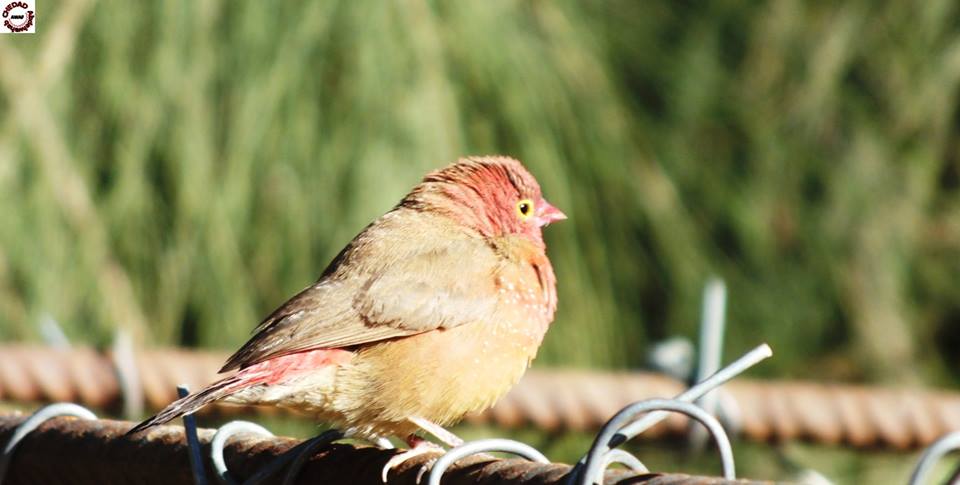The Red-billed Firefinch (Lagonosticta senegala) was introduced at Tamanrasset around 1940. It’s also present at El-Goléa, northern Sahara, since at least 1972 (Isenmann & Moali 2000).
Currently, the species still present at the known sites cited above.
Tamanrasset, Tamanrasset Province:
The species is still present in the town and it’s easily seen there in good numbers. Observed there as recently as last February (photo 1).

El-Goléa, Ghardaïa Province:
The species is still present at this site as well. Abdelwahab Chedad observed a group of 7-10 birds in January 2016 at Hassi el-Gara near El-Goléa wetland (photo 2). However, there is no indication on whether the species is abundant as is the case at Djanet for example (see below).

Recent range expansion
Since at least the end of the 20th century, the species appeared (introduced and/or naturally) in new regions. As these newly colonised areas are located north of species’ main stronghold (Tamanrasset), we can see a general northward expansion of the species. This range expansion is mainly aided by human activities, but natural expansion may have been involved as well in some areas (e.g. at Djanet and Tassili n’Ajjer region) .
Here are the new areas colonised by the species during the last two decades.
Djanet, Illizi Province:
Very abundant and easily seen at Djanet town, the oasis and the nearby villages as well (e.g. at Efri). The species is observed regularly at Djanet by Bilel Gueroui, who photographed there a Sudan Golden Sparrow last January. Isenmann & Moali (2000) explicitly wrote that “the species has never been recorded at Djanet…”, so apparently the species has spread to that region during the last 17 years.
Khaled Ayyach, who also said that the species can be seen in big numbers at Djanet, added that he didn’t observe a single caged bird during his 2 years stay in the town. This can only suggest that the Red-billed Firefinches may have spread naturally to Djanet and Tassili n’Ajjer in general.

In Salah, Tamanrasset Province:
Farid Belbachir wrote in his article about the Africain Silverbill published in 2000: “Red-billed Firefinch…introduced recently to In-Salah, where we observed it from 29 September to 6 October 1997″. Farid Belbachir said that the species is still present at this town, and added in the comments that it was introduced there around the 1990s.
Hassi Moumene, Tamanrasset Province:
A gas field located some 60 Km from the town of In Salah. Robert Minshull observed a pair copulating at this site earlier this month, and added that it’s likely to breed in a reed bed within the camp base (see Rob’s full comment below).
Was the Red-billed Firefinch really introduced at Tamanrasset?
Because the species present just to the south in Mali (Adrar Tigharghar) and Niger (Aïr Mountains), one may think why the species in considered ‘introduced’ in Tamanrasset? The information about the species introduction to Tamanrasset is attributed to Heim de Balsac & Mayaud (1962). Having no access to this reference, I asked this question to some Algerian colleagues, and Farid Belbachir (University of Béjaïa) kindly gave this answer:
“It appears that the species was introduced at Tamanrasset by a former French garrison leader named Florimond. The inhabitants of Tamanrasset attribute the name ‘ferrima’ to the Red-billed Firefinch, a name which could be a deformation of ‘Florimond’”.
References
Belbachir, F. 2000. Première observation d’une colonie de Capucin bec-d’argent Euodice cantans, dans le Sahara Central algérien. Alauda 68: 149–151.
Heim de Balsac, H. & Mayaud, N. 1962. Les oiseaux du Nord-Ouest de l’Afrique. Lechevalier, Paris.
Isenmann, P. & Moali, A. 2000. Oiseaux d’Algérie / Birds of Algeria. SEOF, Paris.
Acknowledgements
Many thanks to Farid Belbachir, Khaled Ayyach, Samir Amarouche, Abdelwahab Awaf Chedad and Bilel Gueroui for providing the information and the photographs. Thanks also to Ali Mehadji for his interest in the discussion.
Observed a pair at Hassi Moumene earlier this month. The site is a remote location; a gas field operated by In Salah Gas. I believe approx 60km from In Salah town.
The pair were observed copulating and are likely to breed in a reed bed within the camp base. Not seen at this location before.
Thanks Robert for the comment. It shows that the species is expanding at this region as well (like the case at Djanat).
Firefinches have been introduced at In Salah through individuals captured in Tamanrasset . I personally know the person who had introduced the species there circa 1990s. Best wishes.
Thanks again Si Belbachir!
The species appears to expand north as the recent observation of Rob Minshull suggest.
I only can add that Isenmann & Moali, (2000) had already mentioned in their work that one couple observed in Aïn Salah on February 7, 1987 (H. Stadelmaier).
Best regards,
Karim